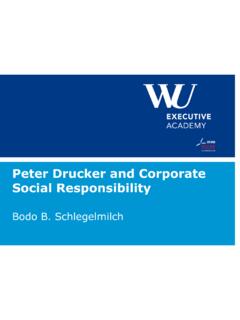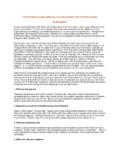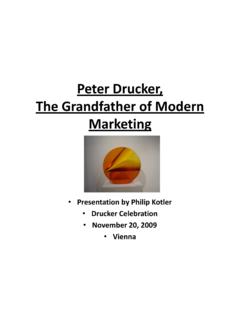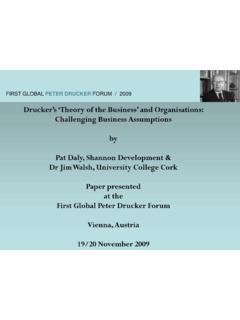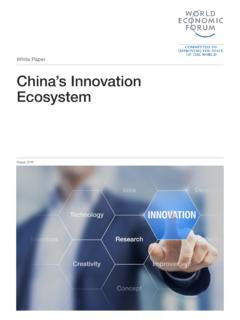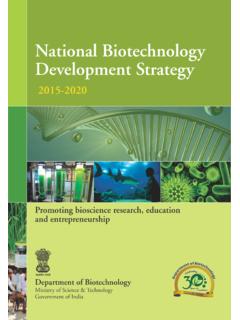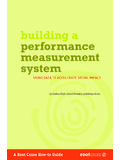Transcription of The Challenge to Rekindle - Peter Drucker
1 The Challenge to Rekindle China s Innovative SpiritDr Anton KrizFaculty of Business and LawNewcastle Business School19thNovember 2009 December 14, 2009A presentation at First Global Drucker Forum 2009 Vienna2 Until AD 800 or 900, China was far ahead of any western country in technology, in science, and in culture and civilization altogetherPeter Drucker , 1989, pp. 245-246 December 14, 2009A presentation at First Global Drucker Forum 2009 Vienna3So what happened why didn t China continue its ascendance? This is called the Needham Question -after Joseph Needham who wrote the definitive works on China s technological paper traverses the history but importantly also looks at whether China s creative innovation can be rekindled December 14, 2009A presentation at First Global Drucker Forum 2009 Vienna4 Background & synopsis Addresses a key issue in China s next stage of development: their propensity to create new things and innovate Attempts to take on Peter Drucker s Challenge of the hard work of thinking conceptual paper Findings.
2 China has a long history of successful innovation However, Confucian belief, a single despot and a closing off to the rest of the world have thwarted its innovative edge Key to rekindling the entrepreneurial spirit will be based on balancing the institution of Government with the needs of a creative class This article identifies that much of this change will rely on quality-related developments rather than financial stealth China s success in innovation will have substantial implications for developed nations both economically and geo-politicallyDecember 14, 2009A presentation at First Global Drucker Forum 2009 Vienna5 Introduction An unprecedented transition has occurred since Deng Xiaoping changed China s path and identified to get rich is glorious China s GDP growth over the last two decades has been maintained at a staggering 9-10% According to the World Bank 500 million Chinese have escaped poverty during this period However, arguably China s greatest Challenge this century is to Rekindle its innovative spirit (Schumpeter, 1939) A battle that will need conquering within (Hutton, 2006.)
3 Arrighi, 2007) China s rapid development under a planned state but a market economy is one of the greatest experiments in history One country two systems December 14, 2009A presentation at First Global Drucker Forum 2009 Vienna6 Insights from Peter Drucker China is a great cost innovator ( factory of the world ) and has a SCA in this area China s great longer-term barrier is to go beyond imitation and cost innovation to imagination, creation and invention Given his views on market economies it s likely Peter Drucker (2002c) would recommend that China focus on knowledgeand people In China s case this means mobilising a complex cultureand its requisite institutions Presciently Drucker (1992, p.
4 95) identified that we were entering a new story about world history and world civilisation and not about a Western-centric worldview Note: Obama s visit this week; builds on rapid rise since 1978 which includes WTO acceptance, Olympic flame , upcoming Shanghai expo and China s repositioning as Asia s middle kingdom December 14, 2009A presentation at First Global Drucker Forum 2009 Vienna7 The focus here is creative innovation Schumpeter (1939) identified innovation as the driving force of an economy -devastates some but rewards others Creative destruction is channelled through entrepreneurial free spirits Various views exist on what constitutes innovation.
5 Innovation is the specific function of is the means by which the entrepreneur creates new wealth-producing resources or endows existing resources with enhanced potential for creating wealth . ( Drucker 2002a , p. 95) Creativity is thinking up new things. Innovation is doing new things. (Theodore Levitt as cited in Shapiro, 2002, p. 7) Radical and disruptive innovation (Christensen, 2000) around creative intelligence (Rowe, 2004) using imagination, creativity and invention (Robinson, 2009) is the focus Includes expertise, creative thinking skills and motivation (Amabile, 1998, p. 78)December 14, 2009A presentation at First Global Drucker Forum 2009 Vienna8 The focus is also China Inc as a unique institution (organisation) North s (2005) suggests informal and formal institutions help shape people s behaviour and interactions Institutions have a potential to affect an individual s habits, conceptions and preferences (Hodgson 2003 , p.)
6 154) This has profound implications for China Ricky Yan (1994) offers a key insight into the softer attributes of Chinese society Foreigners need to understand guo qingor Chinese special local characteristics China is no ordinary society, but one of the last communist frontiers where the institution of Government has a direct role Peter Drucker (leading advocate on management organisations) was privy to some of the great conversations in history on such issues The real battle for China is Government-centric and will be a function of how the polity copes with, supports and encourages more liberalised people (potential freer spirits)December 14, 2009A presentation at First Global Drucker Forum 2009 Vienna9 China s cultural traditions (5000 years in one slide) Well known philosophers like Confucius and Laozi, strategists like Sunzi, and legalists like Han Fei all played a role in China s development Confucius central thesis proffered the benefits of moral virtue Led to a non-litigious society reliant on the rule of man with xinren(trust) and guanxi(relationships and connectedness)
7 Becoming informal surrogates for a lack of formal systems trust Confucian and other Chinese values have positive and negative values in relation to aspects like innovation Ritual and observance provide discipline (help convergent thinking) but are likely to hamper eureka moments (hamper divergent thinking) A historical lack of encouragement for merchants and mercantilism as opposed to mandarins and public service has also deviated China off its technological inventive path (Winchester, 2008). December 14, 2009A presentation at First Global Drucker Forum 2009 Vienna10 History of innovation and diverging worldviews It is a common-place irony that three inventions which helped to establish western world hegemony the magnetic compass, gunpowder and the printing press had been known in China for centuries before they appeared in Europe.
8 (Fernandez-Amesto 1995, p. 680) Needham found many more Chinese resourcefulness and way of thinking enabled such early technological development Why the Chinese have not harnessed this goes back to institutional changes around 200BC and an Emperor s catalytic conversion in the 1400s Brown (1991) identified a human universal that he believes is innate to all: West rationalise in a binary dyadic way However, Chinese made a gestalt shift -this variation has its roots in philosophy and the pursuit of holism and harmony and aspects like yin-yang Meanwhile the West adopted the technology and added scientific method and industrialisation while China stagnated and the rest as they 14, 2009A presentation at First Global Drucker Forum 2009 Vienna11 China s recent record and global innovation ranking The Chinese are trying to catch up -modern China s evolution as an innovative nation can be divided into five key stages (Xie & White, 2006).
9 Stage 1 (1949-1960) started with the emergence of Mao s People s Republic of China and an industrialisation around bedrock industries. Stage 2 (1960-1978) saw increasing tensions between the Soviet Union and Mao; and the Cultural Revolution Stage 3 (1978-1991) was the catalyst for the new Open Door Policy (1978) Stage 4 (1992-2000) saw a revitalisation of local industry with FDI channelled to broader activities Stage 5 (2001 onwards) and the modern Chinese industrial revolution Has lifted China in the global innovation rankings (37thon Global Innovation Index) with of GDP now targeted at R&D. Other targets include technological advances to 60% and becoming top 5 in the world for patents and science citations Pure numbers will help but I argue the key is likely to come from 4 softer qualitative elementsDecember 14, 2009A presentation at First Global Drucker Forum 2009 Vienna12 China s future innovative development (1).
10 Learning and innovation The Chinese Imperial Examination system is legendary and has provided a solid process of meritocracy and governance (Dreyer, 1996) A number of the principles have been adopted in China s modern school based system Abundance of social equity can be tapped (China s pure numbers) However, it s the qualityof social capital not the quantitythat enables creative innovation 3 common elements in best systems of education (Barber & Mourshed, 2007): they recruit quality people to teaching; they ensure these people have excellent instruction; they make sure this level of instruction is accessible to every student China has to nurture knowledge workers to go beyond brute force innovation (Kao 2009) and grow creative intelligence (Rowe, 2004) As Drucker (2006, p.)

